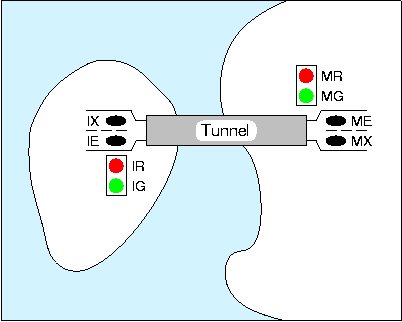
| CSCI P545 | Mon Mar 28 16:04:05 EDT 2011 © [SDJ] |
This problem is a refinement of the standard Traffic Light Control problem and has also been compared to the Clayton Tunnel Disaster. It is a metaphor for coordinating access to a restricted resource. Concurrent entry/exit is allowed under certain conditions, represented by a one-lane tunnel between the Mainland and an Island that may at any time contain several vehicles. There is a bound on the number of vehicles that may be on the island.

We want to design a controller for the red (MR and IR) and green (MG and IG) traffic lights at the each end of this tunnel. There are four sensors for detecting the presence of vehicles: one at tunnel entrance on the island side (IE), one at tunnel exit on the island side (IX), one at tunnel entrance on the mainland side (ME), and one at tunnel exit on the mainland side (MX).
| E1 | The vehicle sensors are conditioned signals, that is, clean pulses of significant duration. |
| E2 | Every vehicle that crosses a sensor is detected and every gap between vehicles that cross a sensor is detected. |
| E3 | Vehicles going into the tunnel are detected before they reach the traffic light; vehicles leaving the tunnel are detected after they leave the single-lane portion of the roadway. |
| E4 | Vehicles don't break down. They obey the traffic signals in finite time, and, if necessary, a bound may be placed on this time. Every vehicle that approaches the tunnel is committed to entering it. |
| E5 | Having arrived on The Island every vehicle eventually tries to leave. |
| D1 | Light Behavior. The traffic lights each follow a red, green, red, green, . . . sequence. Since we have not included a ``caution'' light in this model, this property is satisfied trivially. It may also be assumed, for simplicity, that all vehicles can react instananeously to a change in the traffic light, so that explicit duration timers are not needed in this model. | |
| D2 | Safety. At no time are there two vehicles in the tunnel that are traveling in opposite directions. | |
| D3 | Liveness. Any vehicle attempting to reach or leave the island eventually succeeds. | |
| D4 | Access. Traffic on the island is limited. At no time are there more than 16 vehicles on the island. | |
| D4 | Single Controller. One may design a single controller for both the mainland and island entries. As a variation, one may optionally require seperate, asynchronous controllers at both ends of the tunnel, and impose constraints on communication bandwidth between them. However, under any such variation, the external signature (IE, IX, IR, IG, ME, MX, MR, MG) of their composition must be preserved. | |
Design Model. Code your design model in the form of a SMV module:
MODULE itc_control(IE, IX, IR, IG, ME, MX, MR, MG) ...
Thus, all restrictions and assumptions about the behavior of the input signals should be external to itc_control module.
It is recommended that you encapsulate these constraints in another module
describing the operating environment of the design
being verified. You may wish to define a module called
environment for this purpose:
MODULE itc_environment(IE, IX, IR, IG, ME, MX, MR, MG) ...
For itc_environment modules,
In summary, your .smv files should have the following general form
You will likely need additional variables, for example, to count cars. MODULE itc_control(IE, IX, IR, IG, ME, MX, MR, MG)
Your code here
Your code here
Part A Write your controller and environment modules and your correctness specifications.
Part B Once you are satisfied that everything is right, send the source of your itc_control only to the instructor. All control modules will be posted. Verify each module in composition with your itc_environment module. Summarize the results in a report.
You may but are not required to
describe any failures in terms of observable signals
IX, IW, IR, IG, MX, ME, MG and MR only
In other words, do not "debug" others' modules.
IX, but do not
Discussion points